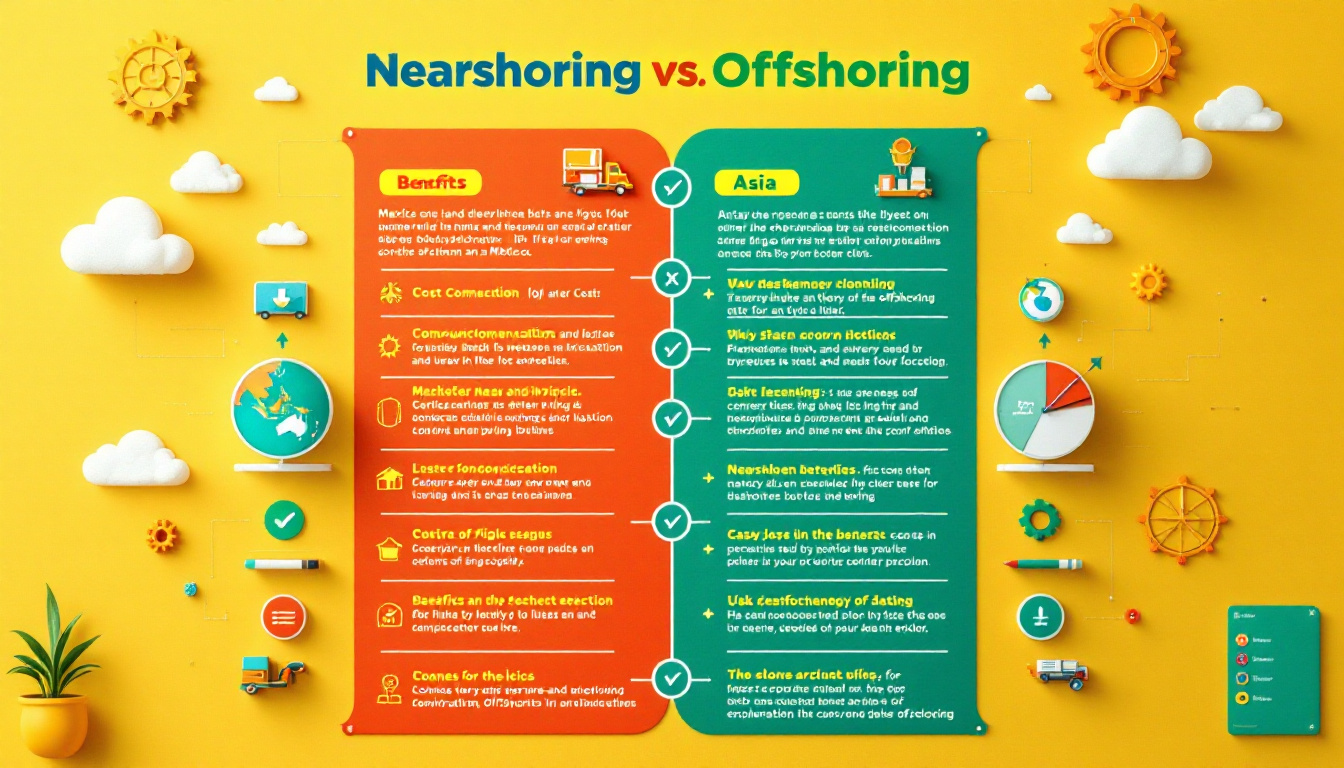Comparative Analysis – Nearshoring in Mexico vs. Offshoring in Asia
As globalization continues to shape the business landscape, companies are increasingly faced with the decision of whether to nearshore or offshore manufacturing and service operations. This article provides a comparative analysis of nearshoring in Mexico and offshoring in Asia, focusing on various factors such as economic landscapes, labor markets, regulatory environments, and cultural considerations.
Understanding Nearshoring and Offshoring
Before diving into the specifics, it is essential to define what nearshoring and offshoring entail. While both strategies aim to optimize costs and resources, they involve different geographical considerations and implications for businesses.

Defining Nearshoring
Nearshoring refers to the practice of relocating business processes or manufacturing to a nearby country, often to optimize communication and reduce logistical challenges. For many companies in the United States, Mexico has become a popular nearshoring destination due to its proximity, similar time zones, and trade agreements like the United States-Mexico-Canada Agreement (USMCA).
Nearshoring allows businesses to maintain tighter control over operations, streamline their supply chains, and respond quickly to market changes or customer demands. Additionally, the cultural affinity and linguistic similarities between the U.S. and Mexico foster collaboration and ease of integration. The reduced travel time for management and oversight also enhances the ability to build strong relationships with local teams, which can lead to improved innovation and responsiveness in product development.
Moreover, nearshoring can contribute to sustainability efforts, as shorter transportation distances reduce carbon footprints associated with shipping goods. Companies are increasingly recognizing the importance of environmentally responsible practices, and nearshoring can be a strategic move to align business operations with these values. This shift not only appeals to eco-conscious consumers but also positions companies favorably in an evolving regulatory landscape that increasingly prioritizes sustainability.
Defining Offshoring
On the other hand, offshoring involves relocating business processes to countries that are often far away, primarily to achieve cost savings. Asia has long been a preferred destination for offshoring due to its established infrastructure, lower labor costs, and a well-developed ecosystem for various industries.
While offshoring can lead to significant cost reductions, it can also introduce challenges related to time zone differences, cultural barriers, and potential communication gaps. Companies must weigh these complexities against the potential for substantial savings and access to a vast talent pool. Furthermore, the offshoring model often necessitates a more robust management strategy to ensure that quality standards are met and that the offshore teams are aligned with the company’s goals and values.
In addition, offshoring can provide access to specialized skills that may not be readily available domestically. For instance, countries like India and the Philippines have developed strong capabilities in IT services and customer support, making them attractive destinations for companies looking to leverage technology and enhance their service offerings. However, businesses must remain vigilant about the potential risks associated with offshoring, such as geopolitical instability, changes in trade policies, and the impact of global economic fluctuations, which can affect operations and profitability.
The Economic Landscape of Mexico and Asia
The economic landscape plays a crucial role in determining the viability of nearshoring versus offshoring. Both regions offer distinct advantages, influenced by their economic indicators, industry presence, and market potential.
Economic Overview of Mexico
Mexico boasts a rapidly growing economy, characterized by its diverse industries ranging from manufacturing to technology services. As of 2023, Mexico has seen a steady increase in foreign direct investment (FDI), particularly in the manufacturing sector, due to its favorable trade agreements and infrastructure development.
The country is well-positioned to support industries such as automotive, electronics, and aerospace, making it an attractive spot for businesses looking to nearshore. Furthermore, the government actively promotes initiatives to enhance workforce training and education, ensuring a continuous supply of skilled labor. This focus on education is crucial, as it aligns with the demands of modern industries that require not only technical skills but also adaptability and innovation. The establishment of numerous technical institutes and partnerships with private enterprises has further strengthened this initiative, creating a robust pipeline of talent ready to meet the evolving needs of the market.
Economic Overview of Asia
Asia, with its vast array of countries, presents a multifaceted economic landscape. While countries like China and India have dominated the offshoring market for years, emerging economies such as Vietnam, Thailand, and the Philippines are also gaining traction.
China remains a financial powerhouse, providing extensive manufacturing capabilities. However, rising labor costs and geopolitical tensions are prompting companies to explore alternatives within the region. India, known for its massive pool of IT professionals and customer service representatives, continues to thrive as a major offshoring destination, particularly for tech-driven industries. The Indian government has also been proactive in fostering a startup culture, offering incentives and support for innovation, which has led to the emergence of numerous tech hubs across the country. This dynamic environment not only attracts foreign investment but also encourages local entrepreneurship, further diversifying the economic landscape.
Labor Market Comparison
The labor market is a significant consideration when evaluating nearshoring versus offshoring. A skilled and available workforce can mean the difference between successful operations and operational struggles.

Workforce Skills and Availability in Mexico
Mexico has a substantial pool of skilled labor, particularly in technical fields. The country’s proximity to the U.S. has enabled numerous educational institutions to collaborate with American universities, leading to a workforce that is not only skilled but also familiar with American business practices.
Moreover, the Mexican government has made strides to enhance vocational training programs aimed at increasing the employability of its workforce. This focus has resulted in a growing number of engineers and technicians who are trained in industries critical for successful nearshoring. Additionally, the rise of technology hubs in cities like Guadalajara and Monterrey has fostered innovation and entrepreneurship, creating a vibrant ecosystem that attracts foreign investment and encourages the development of new skills among the workforce.
Workforce Skills and Availability in Asia
Asia’s labor market is equally impressive, albeit varied from country to country. Nations like India produce millions of graduates each year, particularly in engineering and technology, making it a top choice for IT services and software development.
However, some Asian countries may face challenges related to the availability of specialized skills, particularly in manufacturing. While countries like Vietnam are catching up, they may still lack the level of skilled labor found in more established economies like Japan and South Korea. Furthermore, the rapid pace of technological advancement in these regions necessitates continuous upskilling and reskilling of the workforce, prompting governments and private sectors to invest heavily in training programs. This investment not only addresses the current skill gaps but also prepares the workforce for future demands, ensuring that they remain competitive in a global market that is constantly evolving.
Regulatory Environment
The regulatory environment is a crucial aspect businesses must consider when deciding between nearshoring and offshoring. Regulations can significantly impact operational efficiency and compliance costs.
Business Regulations in Mexico
Mexico offers a relatively business-friendly environment, bolstered by trade agreements designed to facilitate cross-border transactions. The USMCA, for example, eliminates tariffs on many goods and simplifies the process of trade between the U.S., Canada, and Mexico.
While there are regulatory hurdles, such as labor laws and environmental standards, the Mexican government has demonstrated a commitment to attracting foreign investment through various initiatives. However, businesses must remain vigilant about compliance with local regulations to avoid potential pitfalls. For instance, understanding the nuances of the Mexican tax system, which includes Value Added Tax (VAT) and various local taxes, is essential for maintaining financial health. Furthermore, companies should familiarize themselves with the Mexican labor laws, which emphasize workers’ rights and benefits, to ensure they foster a compliant and ethical workplace.
Business Regulations in Asia
In contrast, Asia presents a complex regulatory environment that can vary considerably from one country to another. For instance, while China has made strides in easing restrictions on foreign investments, IP (Intellectual Property) concerns remain a significant issue.
Countries like Thailand and Malaysia have developed more business-friendly frameworks, but navigating bureaucratic red tape can still pose challenges. Businesses must conduct thorough research to understand the regulatory landscape of their target offshoring destination to avoid unexpected complications. Additionally, companies should be aware of the varying labor laws across Asian countries, which can affect hiring practices and employee relations. For example, while some nations may offer flexible labor regulations, others may impose strict employment contracts and termination processes. This diversity necessitates a tailored approach to compliance, ensuring that businesses not only adhere to local laws but also align with cultural expectations and practices to foster positive relationships with local stakeholders.
Cultural and Language Considerations
Cultural compatibility and language barriers are pivotal factors affecting collaboration and communication within international teams. Understanding these elements helps businesses anticipate challenges and enhance team integration.

Cultural Aspects in Mexico
Mexico shares many cultural affinities with the United States, which can facilitate smoother business interactions. A strong emphasis on personal relationships and face-to-face communication typifies the Mexican business culture, fostering trust and collaboration.
Moreover, a significant portion of the Mexican population speaks English, particularly in urban areas and within industries that engage with foreign businesses. This linguistic advantage can significantly reduce communication barriers, making Mexico an appealing option for nearshoring.
Additionally, the Mexican culture values family and community, which can translate into a strong team-oriented approach in the workplace. This collective mindset often leads to a supportive atmosphere where employees feel valued and motivated to contribute to group success. Furthermore, Mexican holidays and traditions, such as Día de los Muertos and Independence Day, can provide opportunities for team bonding and cultural exchange, enriching the overall work experience.
Cultural Aspects in Asia
Conversely, cultural differences in Asia can pose challenges for businesses looking to offshore. Each country has its unique cultural nuances, which can affect everything from negotiation styles to project management approaches.
In countries like India, a hierarchical structure may influence communication and decision-making processes, while in China, establishing relationships before conducting business is crucial. English proficiency varies widely as well, which may necessitate additional resources to ensure efficient communication.
Furthermore, the diversity within Asia means that businesses must be particularly mindful of regional customs and practices. For instance, in Japan, the concept of ‘wa’ or harmony is essential, leading to a preference for consensus-based decision-making. Understanding these subtleties can help foreign companies navigate the complexities of Asian markets more effectively. Additionally, cultural events and festivals, such as Diwali in India or the Lunar New Year in China, can serve as valuable touchpoints for building rapport and demonstrating respect for local traditions.
Overall, the decision to nearshore in Mexico or offshore in Asia will depend on various factors, including cost, labor availability, regulatory environments, and cultural considerations. Each option has advantages and challenges, and companies should carefully assess their unique needs and long-term strategic goals before making a decision.
Discover the Benefits of Nearshoring with Nearshoring in México
Choosing the right strategic location for your business operations is critical. Nearshoring in México offers a unique opportunity to capitalize on the strengths of Mexico’s workforce and business climate. If you’re looking to enhance efficiency, reduce costs, and stay agile in a competitive market, our services at Nearshoring in México are tailored to meet your needs. Learn More about how we can help you optimize your operations and gain the competitive edge you’re looking for.
